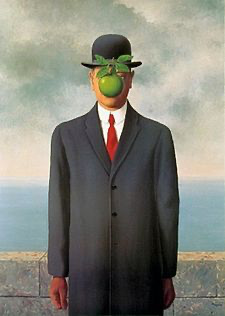Introduction
I chose “The Son of Man” by René Magritte, which is a 1964 painting. Magritte is most famous for his “The Treachery of Images” or “This is not a pipe” (Ceci n’est pas une pipe) work, as well as many others. Below is the image of the painting I am discussing in this response (“The Son of Man, 1946 by Rene Magritte,” n.d.):

This painting was done using oil paint on a canvas and is currently a part of a private collection.
Description
The dimensions of the canvas are 45.67 in × 35 in. As can be seen from the picture above, it is a depiction of a man in a long overcoat standing in front of a pier, with a green apple in front of his face. In fact, the painting is a self-portrait by Magritte and is a part of his series of surrealistic paintings that involve apples and other objects. Other such paintings include two apples on a table with Zorro-Esque masks on their faces and a bust painting of a suit with an apple for a head, among others.
Response
I like the work of Magritte in general, and this is one of my favorite paintings. It represents the hidden parts of man, the absurdity of the difference between the visible and the reality. Magritte himself referred to the feelings one might experience from such secretive nature of the painting as “a quite intense feeling” (“The Son of Man, 1946 by Rene Magritte,” n.d.). I find it especially relevant in the times of the global pandemic, with everyone worldwide wearing masks daily. When meeting someone new today, we are left wondering what they look like under the mask when the whole face is revealed. Figuratively, moreover, this is a metaphor for the way we open up to other people once we feel we can trust them, revealing the hidden parts of our soul.
Conclusion
This work is very successful in conveying its message, and it is not only aesthetically pleasing due to the choice of colors but meaningful. There are multiple layers of meanings to the painting, and it is as relevant today as ever – both with the pandemic and the anonymous nature of online communications. The work is effective, as the apple and the man is highlighted by the brighter colors against the background.
References
The Son of Man, 1946 by Rene Magritte. (n.d.). René Magritte. Web.